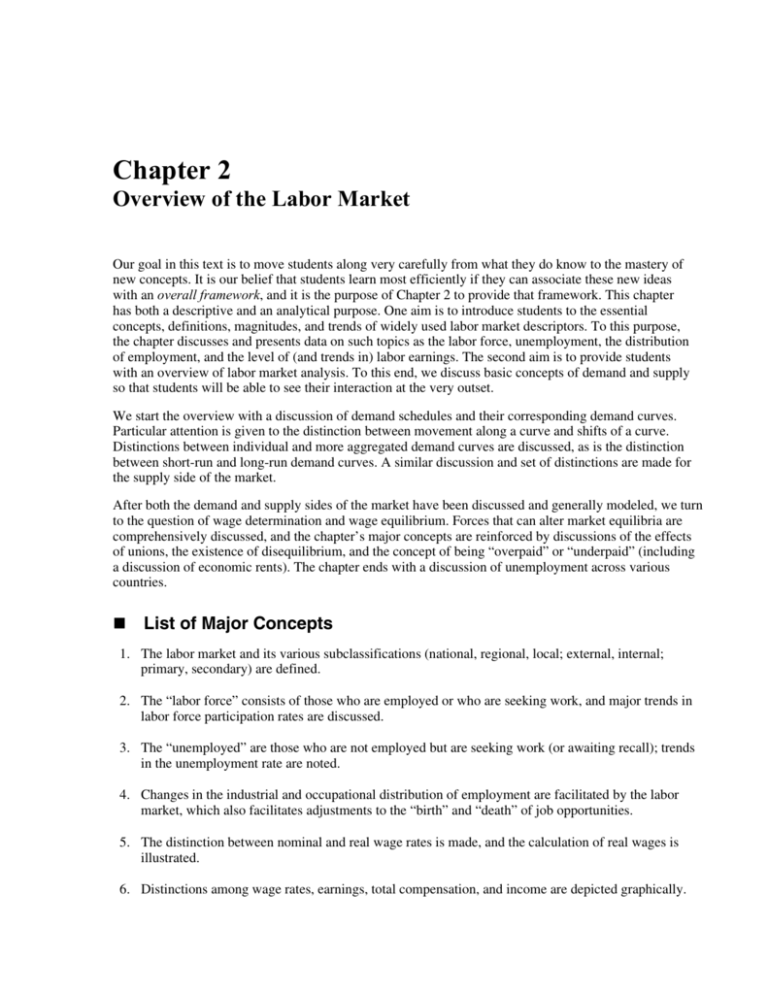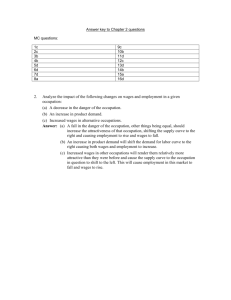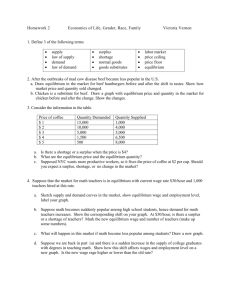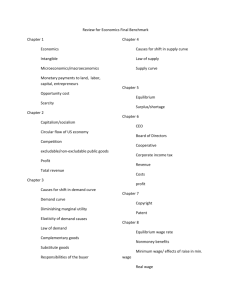Chapter 2 Overview of the Labor Market
advertisement

Chapter 2 Overview of the Labor Market Our goal in this text is to move students along very carefully from what they do know to the mastery of new concepts. It is our belief that students learn most efficiently if they can associate these new ideas with an overall framework, and it is the purpose of Chapter 2 to provide that framework. This chapter has both a descriptive and an analytical purpose. One aim is to introduce students to the essential concepts, definitions, magnitudes, and trends of widely used labor market descriptors. To this purpose, the chapter discusses and presents data on such topics as the labor force, unemployment, the distribution of employment, and the level of (and trends in) labor earnings. The second aim is to provide students with an overview of labor market analysis. To this end, we discuss basic concepts of demand and supply so that students will be able to see their interaction at the very outset. We start the overview with a discussion of demand schedules and their corresponding demand curves. Particular attention is given to the distinction between movement along a curve and shifts of a curve. Distinctions between individual and more aggregated demand curves are discussed, as is the distinction between short-run and long-run demand curves. A similar discussion and set of distinctions are made for the supply side of the market. After both the demand and supply sides of the market have been discussed and generally modeled, we turn to the question of wage determination and wage equilibrium. Forces that can alter market equilibria are comprehensively discussed, and the chapter’s major concepts are reinforced by discussions of the effects of unions, the existence of disequilibrium, and the concept of being “overpaid” or “underpaid” (including a discussion of economic rents). The chapter ends with a discussion of unemployment across various countries. List of Major Concepts 1. The labor market and its various subclassifications (national, regional, local; external, internal; primary, secondary) are defined. 2. The “labor force” consists of those who are employed or who are seeking work, and major trends in labor force participation rates are discussed. 3. The “unemployed” are those who are not employed but are seeking work (or awaiting recall); trends in the unemployment rate are noted. 4. Changes in the industrial and occupational distribution of employment are facilitated by the labor market, which also facilitates adjustments to the “birth” and “death” of job opportunities. 5. The distinction between nominal and real wage rates is made, and the calculation of real wages is illustrated. 6. Distinctions among wage rates, earnings, total compensation, and income are depicted graphically. Ehrenberg/Smith • Modern Labor Economics: Theory and Public Policy, Tenth Edition 6 7. The labor market is one of three major markets with which an employer must deal; in turn, labor market outcomes (terms of employment and employment levels) are affected by both product and capital markets. 8. The concepts underlying a labor demand schedule are associated with product demand, the choice of technology, and the supply schedule of competing factors of production; scale and substitution effects are ultimately related to these forces. 9. Underlying a supply schedule for labor are the alternatives workers have and their preferences regarding the job’s characteristics. 10. Distinctions between individual and market demand and supply curves are discussed. 11. Movements along, rather than shifts of, demand and supply curves occur when wages of the job in question change; when a variable not shown on the graph changes, the curves tend to shift. 12. The interaction of market demand and supply determines the equilibrium wage. 13. Changes in the equilibrium wage rate are caused by shifts in either the demand or supply curves. Disequilibium will persist if the wage is not allowed to adjust to shifts in demand or supply. 14. The concepts of “overpaid” and “underpaid” compare the actual wage to the equilibrium (market) wage rate. 15. Individuals paid more than their reservation wage are said to obtain an “economic rent.” 16. The concepts of shortage and surplus are directly related to the relationship between actual and equilibrium wage rates. 17. Unemployment rates, and especially long-term unemployment rates, have risen in Europe relative to the United States and Canada over the recent decade; this rise may reflect the existence of relatively stronger nonmarket forces in Europe. Answers to Even-Numbered Review Questions 2. Analyze the impact of the following changes on wages and employment in a given occupation: a. A decrease in the danger of the occupation. b. An increase in product demand. c. Increased wages in alternative occupations. Answer: a. A fall in the danger of the occupation, other things being equal, should increase the attractiveness of that occupation, shifting the supply curve to the right and causing employment to rise and wages to fall. b. An increase in product demand will shift the demand for labor curve to the right, causing both wages and employment to increase. c. Increased wages in other occupations will render them relatively more attractive than they were before and cause the supply curve to the occupation in question to shift to the left. This will cause employment in this market to fall and wages to rise. Chapter 2 Overview of the Labor Market 7 4. Suppose a particular labor market were in market-clearing equilibrium. What could happen to cause the equilibrium wage to fall? If all money wages rose with inflation each year, how would real wages in this market adjust? Answer: Starting from the position of equilibrium, a labor market could experience a fall in the equilibrium wage if either the demand curve shifts to the left or the supply curve shifts to the right. While market wages are usually stated in nominal terms, their relationship to the prices of both consumer and producer products is of ultimate importance. Therefore, both parties to the employment relationship are, in the last analysis, concerned with the real wage rate. The real wage rate can fall when the nominal wage rate is rising if prices of consumer and producer products rise even more quickly. 6. Ecuador is the world’s leading exporter of bananas, which are grown and harvested by a large labor force that includes many children. Assume Ecuador now outlaws the use of child labor on banana plantations. Using economic theory in its “positive” mode, analyze what would happen to employment and wages in the banana farming industry in Ecuador. Use demand and supply curves in your analysis. Answer: The labor supply curve to banana producers would clearly shift to the left as children were removed from the labor market. This would raise the wages paid by growers and reduce employment in the sector. 8. American students have organized opposition to the sale by their campus stores of university apparel made for American retailers by workers in foreign countries who work in sweatshop conditions (long hours at low pay in bad working conditions). Assume this movement takes the form of boycotting items made under sweatshop conditions. a. Analyze the immediate labor market outcomes for sweatshop workers in these countries using demand and supply curves to illustrate the mechanisms driving the outcomes. b. Assuming the actions by American students are the only force driving the improvement of wages and working conditions in foreign countries, what must these actions include to ensure that the workers they are seeking to help are unambiguously better off? Answer: a. A boycott has the effect of shifting the demand for apparel made by sweatshop labor to the left, driving down wages and employment. b. To avoid the effects in (a), students in the United States must be willing to buy the same quantity and quality of apparel at higher prices—that is, they must be willing to pay a premium for apparel made by better-paid workers. 10. Suppose we observe that employment levels in a certain region suddenly decline as a result of (i) a fall in the region’s demand for labor, and (ii) wages that are fixed in the short run. If the new demand for labor curve remains unchanged for a long period and the region’s labor supply curve does not shift, is it likely that employment in the region will recover? Explain. Answer: The initial response to a leftward shift in the labor demand curve in the context of fixed wages is for there to be a relatively large decline in employment. This decline in employment is larger than the ultimate decline in employment. The initial disequilibrium between demand and supply in the labor market should force wages down in the long run, and as wages decline firms will move downward along their labor demand curves and will begin to employ more labor. However, employment in the region would recover to its prior level (assuming no subsequent shifts in demand or supply curves) only if the supply curve was vertical; if supply curves are upward-sloping, the declining wage will cause some withdrawal of labor from the market and employment will not recover to its prior level. 8 Ehrenberg/Smith • Modern Labor Economics: Theory and Public Policy, Tenth Edition 12. Assume that the war in Iraq increased the desired size of the military, and assume that potential recruits are reduced by the prospect of facing dangerous, unpleasant wartime conditions. First, analyze how the war affects the demand curve and the supply curve for military personnel. Second, use your analysis to predict how the war will affect the wages and the employment level of military personnel. Answer: War shifts the labor demand curve to the right and shifts the labor supply curve to the left. Higher wages are clearly a result of both shifts, but the effects on the level of military employment are uncertain. Answers to Even-Numbered Problems 2. Suppose that the supply curve for school teachers is Ls = 20,000 + 350W and the demand curve for school teachers is Ld = 100,000 − 150W, where L = the number of teachers and W = the daily wage. a. Plot the demand and supply curves. b. What are the equilibrium wage and employment level in this market? c. Now suppose that at any given wage 20,000 more workers are willing to work as school teachers. Plot the new supply curve and find the new wage and employment level. Why doesn’t employment grow by 20,000? Answer: a. See the figure. Plot the Ld and Ls curves by solving for desired employment at given wage rates. If W = 500, for example, employers desire 25,000 workers (Ld = 100,000 – 150 × 500); if W = 400, they would desire 40,000. Since the equation above is for a straight line, drawing a line using these two points gives us the demand curve. Use the same procedure for the labor supply curve. Chapter 2 Overview of the Labor Market b. To find the equilibrium, solve for the wage at which the quantity of labor supplied equals the quantity of labor demanded: Ls = 20,000 + 350W = 100,000 – 150W = Ld. Solve for W by adding 150W to both sides and subtracting 20,000 from both sides to yield 500W = 80,000. Dividing both sides by 500 reveals that W = $160 per day. Plugging W = $160 into both the labor demand and supply equations shows that L = 76,000 schoolteachers. c. The new labor supply curve is L′s = 40,000 + 350W. Setting this equal to Ld and solving shows that W = $120 per day; L = 82,000 school teachers. Employment doesn’t grow by 20,000 because the shift in the supply curve causes the wage to fall, which induces some teachers to drop out of the market. 4. Suppose the adult population of a city is 9,823,000, and there are 3,340,000 persons who are not in the labor force and 6,094,000 who are employed. a. Calculate the number of adults who are in the labor force and the number of adults who are unemployed. b. Calculate the labor force participation rate and the unemployment rate. Answer: a. Number in labor force = number in population less those not in the labor force = 9,823,000 – 3,340,000 = 6,483,000 Number unemployed = number in labor force minus number employed = 6,483,000 – 6,094,000 = 389,000 b. Labor force participation rate = (labor force/population) × 100 = (6,483,000/9,823,000) × 100 = 66.0% Unemployment rate = (unemployed/labor force) × 100 = (389,000/6,483,000) × 100 = 6.0% 6. The following table gives the demand and supply for cashiers in retail stores. Wage Rate Number of Cashiers Demanded Number of Cashiers Supplied $3.00 4.00 5.00 6.00 7.00 8.00 9.00 200 180 170 150 130 110 80 70 100 120 150 160 175 190 a. Plot the demand and supply curves. b. What are the equilibrium wage and employment level in this market? 9 10 Ehrenberg/Smith • Modern Labor Economics: Theory and Public Policy, Tenth Edition c. Suppose the number of cashiers demanded increases by 30 at every wage rate. Plot the new demand curve. What are the equilibrium wage and employment level now? Answer: a. b. From either the table or the graph, the equilibrium wage is $6.00 per hour and the equilibrium quantity is 150 cashiers. c. From either the table or the graph, the new equilibrium wage is $7.00 per hour and the equilibrium quantity is 160 cashiers.









